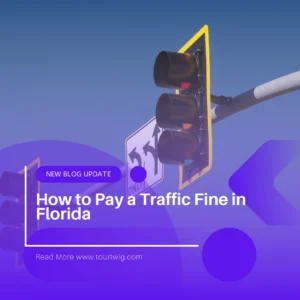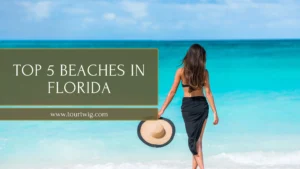For adventurous travelers and boating enthusiasts, traveling from Michigan to Florida by water is thrilling along scenic rivers, lakes, and coastal waterways. This trip combines exploration, navigation, and a love of open water, giving travelers a new way to experience America’s waterways while traveling south to the Sunshine State. If you’ve ever dreamed of bypassing the highways and taking a more leisurely, scenic route to Florida, here’s a comprehensive guide on how to make the trip by boat.
Understanding the Route: The Great Loop Adventure
Traveling by water from Michigan to Florida generally involves following parts of the Great Loop, a well-known waterway route that circles the eastern United States. This loop passes through the Great Lakes, down various rivers, and into the Gulf of Mexico before reaching Florida.


Key Segments of the Journey
- The Great Lakes: Traverse Lake Michigan or Lake Huron to reach Chicago or southern Michigan.
- Inland Rivers: Navigate rivers like the Illinois River, Mississippi River, Ohio River, Tennessee-Tombigbee Waterway, and Mobile River.
- Intracoastal Waterway (ICW): This protected coastal waterway will take you from the Gulf of Mexico through Alabama and along the Florida coastline.
For more blog posts click here.
1. Preparing for the Trip
Traveling by boat from Michigan to Florida requires careful planning. Here’s what to consider before you set sail:
- Choose the Right Boat: A sturdy boat equipped for long distances and changing water conditions is essential. Many boaters use trawlers, motor yachts, or sailboats with an auxiliary engine.
- Safety Equipment: Ensure you have life vests, first-aid kits, flares, emergency signaling devices, navigation systems, and a reliable radio.
- Charts and GPS: Get detailed charts of the Great Lakes, inland rivers, and the Intracoastal Waterway. A GPS navigation system is invaluable for accurate routing.
- Plan for Weather: You’ll be covering multiple regions with varying weather patterns, so keep an eye on weather reports and be prepared to dock if necessary.
2. The First Leg: Departing Michigan and Crossing the Great Lakes
The journey begins by navigating Lake Michigan or Lake Huron, depending on your starting location.
- Lake Michigan Route: Travel south on Lake Michigan toward Chicago, where you can connect to the Illinois River. This route is popular for those starting on the west side of Michigan.
- Lake Huron Route: If departing from eastern Michigan, you can enter Lake Huron and connect to the Detroit River, moving through Lake Erie and then to the Ohio River system.


The Great Lakes offer stunning scenery, but they are also known for their challenging weather and waves, especially in the fall. Timing your trip is crucial, with most boaters opting to start in late summer or early fall to avoid the stormier months.
3. Navigating Inland Rivers: The Illinois and Mississippi Rivers
Once you reach Chicago, you’ll enter the Chicago River and eventually connect to the Illinois River. This leg is unique as you leave the open water of the Great Lakes and transition into inland river systems.
- Illinois River: The Illinois River will lead you to the Mississippi River near Grafton, Illinois. You’ll encounter locks and dams along the way, which are manageable with careful planning and communication with lock operators.
- Mississippi River: Follow the Mississippi River southward, passing through historic towns and scenic river landscapes until you reach Cairo, Illinois, where you’ll connect to the Ohio River.
This part of the journey offers a slower pace with gentle currents, but it’s important to watch for barge traffic on these commercial waterways.
4. From the Ohio River to the Tennessee-Tombigbee Waterway
The Ohio River takes you southeast, where you’ll eventually join the Tennessee River near Paducah, Kentucky. From here, you’ll enter the Tennessee-Tombigbee Waterway (Tenn-Tom), which will bring you south to Mobile, Alabama, and ultimately to the Gulf of Mexico.
- Tennessee-Tombigbee Waterway: This man-made waterway is a peaceful stretch through the southern U.S. and is often less congested. The Tenn-Tom allows boaters to avoid the more turbulent lower Mississippi River.
- Wildlife and Scenery: The Tenn-Tom is known for its beautiful wildlife and scenic landscapes, making this a memorable leg of the journey.
5. Entering the Gulf of Mexico and the Intracoastal Waterway
Once you reach Mobile Bay, you’ll enter the Gulf of Mexico. This stretch of water brings you to the final segment of the journey along the Intracoastal Waterway (ICW).
- Intracoastal Waterway: The ICW provides a sheltered route along the coastline, offering protection from rough ocean waters. You’ll follow this waterway through Alabama, across the Florida Panhandle, and along Florida’s Gulf Coast.
- Gulf Coast Towns: This route is dotted with charming coastal towns like Pensacola, Destin, and Apalachicola, where you can dock, refuel, and explore.
The ICW is perfect for those seeking a smooth, picturesque cruise with access to various marinas, refueling stations, and restaurants along the way.
6. Final Destination: Arriving in Florida
Once in Florida, you can continue exploring the ICW along Florida’s Gulf Coast or cross over to Florida’s Atlantic Coast. There are plenty of beautiful destinations to explore within the state by boat, including:
- St. Petersburg and Tampa: Known for vibrant waterfronts and marinas.
- Fort Myers and Naples: Perfect for relaxing on the beach after a long journey.
- Florida Keys: For a tropical experience, follow the ICW to the Florida Keys, where you can dock in places like Key Largo, Islamorada, and Key West.
Challenges and Tips for the Journey
Traveling such a long distance by boat can be challenging. Here are a few tips to help make your journey smoother:
- Allow Extra Time: Weather, mechanical issues, and lock delays can extend travel time. Give yourself extra time and try not to stick to a rigid schedule.
- Budget for Fuel and Marinas: Depending on your boat type, fuel costs can add up. Also, plan for marina fees, especially during peak seasons.
- Stay Informed: Check waterway conditions, lock schedules, and weather updates. Apps like Navionics and ActiveCaptain can be invaluable for real-time information.
- Know the Waterway Rules: Inland rivers and the ICW have different speed limits and no-wake zones, especially in wildlife areas.
FAQ: Traveling from Michigan to Florida by Water
Q1: How long does it take to travel from Michigan to Florida by boat?
- Answer: The trip generally takes around 4-6 weeks, depending on your speed, stops, and the weather. Some boaters take longer to explore stops along the way.
Q2: What is the best time of year for this journey?
- Answer: Late summer or early fall is ideal, as Great Lakes waters are calmer, and you can reach southern states before winter.
Q3: Do I need special permits to navigate the rivers and ICW?
- Answer: No special permits are needed, but you’ll need to comply with local navigation rules and regulations for each state.
Q4: What type of boat is recommended?
- Answer: Trawlers, motor yachts, and sailboats with auxiliary engines are popular choices due to their comfort, durability, and fuel efficiency.
Q5: Can I dock and explore cities along the way?
- Answer: Yes! The route offers multiple docking options in cities like Chicago, St. Louis, Mobile, and various Florida coastal towns.
Q6: How do I navigate the locks?
- Answer: Approach the locks slowly, contact the lock operator on VHF radio, and be prepared to secure your boat to prevent shifting.
Conclusion: Embrace the Adventure
Traveling by water from Michigan to Florida is an unforgettable journey that lets you experience the beauty and diversity of America’s waterways. From the grandeur of the Great Lakes to the charm of the Gulf Coast, every leg of the trip offers new sights, towns, and adventures. So, if you’re ready to chart a course from Michigan to the Sunshine State, plan well, embrace the pace, and set sail on the ultimate boating adventure.





